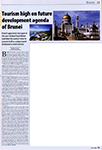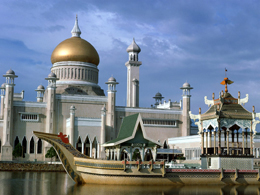Tourism high on future development agenda of Brunei |
 |
<<Click to see original |
Brunei’s appearance once again at this year’s Arabian Travel Market underlines the country’s vision to promote itself as a unique tourist destination in South East Asia.

Brunei Darussalam (literally: Brunei, Abode of Peace) owes its prosperity to its abundant oil and gas resources which account for 94% of Government revenue; and many worry that this leaves the country vulnerable to external shocks, particularly given the prospect of an eventual depletion of these resources over the next couple of decades. For this reason, tourism is high on the agenda for the future development of the sultanate.
GDP per capita in Brunei is almost on a par with Singapore's, but Singapore has no natural resources and all of its GDP per capita increases over the last 40 years since independence have come from a diversified pool of sectors such as banking and finance, services, tourism and manufacturing. In contrast, government, construction, services, retail and some light manufacturing play only a very small part in Brunei's economy, so its government is now working towards economic diversification — in which tourism plays an important role — as well as encouraging foreign investment and developing education and human resources.
Some 226,000 tourists visited the Sultanate last year, and on the basis that if each tourist spent $100 per day during a three-day visit, the resulting $68 million represents a significant boost to the local economy.
With over two thirds of its population professing the Islamic faith, and with the country offering a wide variety of attractive places enjoying a moderate equatorial climate throughout the year, the Middle East is seen as a key market to be exploited in the drive to attract tourists to this tiny country that occupies a mere 1% of Borneo's land area. Brunei is known for its opulence and is home to a number of high-end hotels, including the renowned Empire Hotel & Country Club, where guests can indulge themselves in extreme luxury. But Islamic influences form a central foundation of the nation’s heritage, with many cultural practices and customs intrinsically linked with religion.
Around 43 percent of visitors come from ASEAN countries with a further 24 percent from the Far East. Less than half of one percent is accounted for by Middle Eastern visitors, however, which means there is a huge potential for growth. Despite nearly a doubling of overall visitor numbers in the years 2005 to 2008, the start of this year saw a 13 percent fall on the previous year, put down to the worldwide economic slowdown.
One particular sector that is being specially targeted is sports tourism. In addition to golf events such as the Aberdeen Brunei Senior Masters, the Brunei Darussalam Cycling Federation has just hosted the first ASEAN regional mountain biking competition, held at the Berakas Forest Recreational Park, whilst other sports such as jungle trekking, horse riding, diving and other water sports are being actively promoted as a means of attracting visitors to the country. Eco-tourism and culture are also strongly highlighted in the government's campaign to promote the sultanate as a tourist destination.
Meanwhile, passengers on the Europe to East Asia or to Australia and New Zealand routes, who transit in Brunei for more than four hours also now have the opportunity to enjoy a free city tour of the country's famous tourist attractions, including visits to the historical water village, Kampong Ayer, the Sultan Omar Ali Saifuddien Mosque, the Royal Palace or Istana Nurul Iman and Jame' 'Asr Hassanil Bolkiah Mosque. There is also a stop at the Sumbangsih Mulia complex, which showcases local traditional handicrafts.
